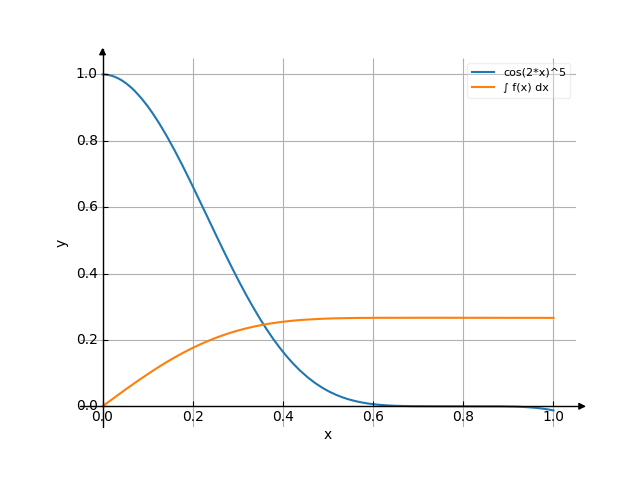Integral of cos^5(2x) dx
The solution
1 / | | 5 | cos (2*x) dx | / 0
-
Rewrite the integrand:
-
There are multiple ways to do this integral.
Method #1
-
Let .
Then let and substitute :
-
Integrate term-by-term:
-
The integral of a constant times a function is the constant times the integral of the function:
-
Let .
Then let and substitute :
-
The integral of is when :
Now substitute back in:
-
So, the result is:
-
-
The integral of a constant times a function is the constant times the integral of the function:
-
Let .
Then let and substitute :
-
The integral of is when :
Now substitute back in:
-
So, the result is:
-
-
The integral of a constant times a function is the constant times the integral of the function:
-
The integral of cosine is sine:
So, the result is:
-
The result is:
-
Now substitute back in:
-
Method #2
-
Rewrite the integrand:
-
Integrate term-by-term:
-
Let .
Then let and substitute :
-
The integral of a constant times a function is the constant times the integral of the function:
-
The integral of is when :
So, the result is:
-
Now substitute back in:
-
-
The integral of a constant times a function is the constant times the integral of the function:
-
Let .
Then let and substitute :
-
The integral of a constant times a function is the constant times the integral of the function:
-
The integral of is when :
So, the result is:
-
Now substitute back in:
-
So, the result is:
-
-
Let .
Then let and substitute :
-
The integral of a constant times a function is the constant times the integral of the function:
-
The integral of cosine is sine:
So, the result is:
-
Now substitute back in:
-
The result is:
-
Method #3
-
Rewrite the integrand:
-
Integrate term-by-term:
-
Let .
Then let and substitute :
-
The integral of a constant times a function is the constant times the integral of the function:
-
The integral of is when :
So, the result is:
-
Now substitute back in:
-
-
The integral of a constant times a function is the constant times the integral of the function:
-
Let .
Then let and substitute :
-
The integral of a constant times a function is the constant times the integral of the function:
-
The integral of is when :
So, the result is:
-
Now substitute back in:
-
So, the result is:
-
-
Let .
Then let and substitute :
-
The integral of a constant times a function is the constant times the integral of the function:
-
The integral of cosine is sine:
So, the result is:
-
Now substitute back in:
-
The result is:
-
-
-
Add the constant of integration:
The answer is:
/ | 3 5 | 5 sin(2*x) sin (2*x) sin (2*x) | cos (2*x) dx = C + -------- - --------- + --------- | 2 3 10 /
3 5 sin(2) sin (2) sin (2) ------ - ------- + ------- 2 3 10
=
3 5 sin(2) sin (2) sin (2) ------ - ------- + ------- 2 3 10

Use the examples entering the upper and lower limits of integration.

![Find the integral of y = f(x) = cos⁵(2x) dx (co sinus of e of to the power of 5(2x)) - with detailed solution [THERE'S THE ANSWER!] cos^5(2x)](/media/krcore-image-pods/176/hash/indefinite/9/b2/e14f1035b42e6ba84ffead6b40311.png)
 Integral of cos^5(2x)
Integral of cos^5(2x)
 Integral of 4cosx
Integral of 4cosx
 Integral of sinx/x^3
Integral of sinx/x^3
 Integral of cos^3x/sin^4x
Integral of cos^3x/sin^4x